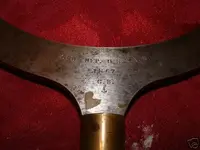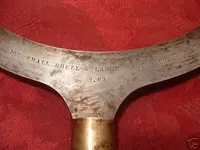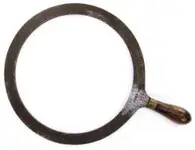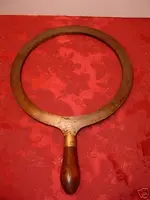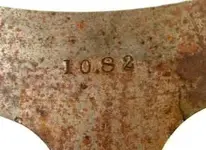Please pardon the delay in replying. I'd been "on the road" for four days. Took a while to recover.
About your iron ball:
As I've said previously, multi-millions of iron (or steel) balls exist which were manufactured for civilian use (such as ball-bearings and Stonemilling Industry rock-crusher balls, etc). So, to distinguish between an Artillery ball and a civilian-usage ball, we artillery historians rely on historical records which tell the very-precise diameter and weight of the various kinds and calibers of Artillery balls used in America from the Colonial era through the Civil War. That very important data is viewable online, for free, here:
Cannon bore, shot, and shell diameters for smoothbore guns
Speaking very frankly, as a longtime relic-digger myself, every time I dig an iron ball I very much
want it to be an Artillery ball.

But speaking as an artillery historian (and an honest relic-dealer), I must suppress my personal desire that my find be an artillery ball, and put it through the "Authentification" tests (precise measuring and weighing) before I put that ball on my relic-show table as an Artillery ball with a pricetag on it.
I appreciate the effort you've put into accurately measuring and weighing your iron ball. As I explained above, that is crucially necessary for "authenticating" it as an artillery ball.
Unfortunately, the Ordnance Manual's "Shot Tables" do not contain a matchup for your 1.259-inch ball.
The two "nearest" matches for it are 1.15/1.16-inch and 1.33/1.34-inch Canister (antipersonnel artillery ammo) balls. People ask me, "Well, why do the balls have to be
exactly the size (in hundredths-of-an-inch) which is specified in the Ordnance Manual?" The answer is: just as with bullets for a rifle, artillery balls
must fit
perfectly into the cannon's bore, or into the Grapeshot assembly, or into the Canister (a tin-can) which contained them. If the projectile is a little too small or too big for its intended use, it won't perform properly. Of course, combat soldiers (and the Ordnance Department) don't like that. So, very strict ammo-size rules were issued, which were enforced by the army and navy's Ordnance Inspectors.
A bit more explanation:
1- See the photos (below) showing artillery Ring Gauges, which are a precision-made "sizing" tools for size-checking artillery balls.
2- You'll notice that the Ordnance Manual's "Shot Tables" charts for artillery balls mention a size-range between "Large-gauge" and "Small-gauge." That meant a ball had to fit through a "Large-gauge" ring but also
not fit through the accompanying "Small-gauge" ring.
Example:
For a 6-Pounder caliber cannon's Canister balls, the hole in the "Small-gauge" ring was 1.14-inches, and in the "Large-gauge" ring was 1.17-inches. So, the iron balls which passed those tests were 1.15-to-1.16-inches in diameter ...and of course, the ball couldn't have any projections (bumps or ridges) which were large enough to prevent the ball from fitting through the ring.
In the photos below, showing two examples of artillery ball "sizing" Ring Gauges, note the markings telling the hole's diameter in
hundredths-of-an-inch,. Also, other explanatory markings, such as "Ord[nance] Dep[artment] U.S.N.Y.W. [United States Navy Yard, Washington DC] 1867."

 But speaking as an artillery historian (and an honest relic-dealer), I must suppress my personal desire that my find be an artillery ball, and put it through the "Authentification" tests (precise measuring and weighing) before I put that ball on my relic-show table as an Artillery ball with a pricetag on it.
But speaking as an artillery historian (and an honest relic-dealer), I must suppress my personal desire that my find be an artillery ball, and put it through the "Authentification" tests (precise measuring and weighing) before I put that ball on my relic-show table as an Artillery ball with a pricetag on it. 